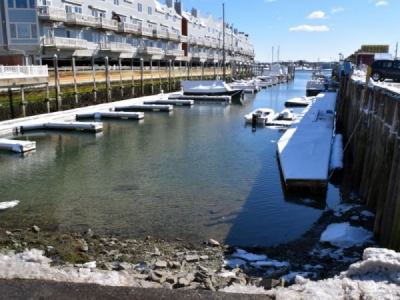
Posted on February 21, 2019
Low tide between Chandler’s and Widgery wharves on Feb. 14. The accumulation of silt may be costing pier owners 10 percent to 30 percent of berths, and dredging and storage could cost $30 million.
PORTLAND — A group of city, state and federal officials digging into the process of dredging areas of the Fore River have found the removal and safe storage of sediment that has accumulated around wharves and piers on both sides of the river could cost $30 million.
“The more we dredge over here, the bigger a hole we have to dig over there,” said Glenn Daukas of Campbell Environmental Group at a Feb. 14 meeting at the Centerboard Yacht Club in South Portland.
Daukas is a senior geologist at the consulting firm hired by the Portland Harbor Commission.
The dredged materials are contaminated and cannot be stored offshore. Instead, they will be held in a confined aquatic disposal cell, commonly called a CAD cell.
That part of the project is being handled by Stantec, an engineering firm with offices in Scarborough.
At least $600,000 from two grants has been spent to identify and test sediment, dredge sites and for the storage area. The dredging work has been funded through Brownfields grants from the U.S. Environmental Protection Agency and Maine Department of Environmental Protection.
The Maine Department of Transportation has funded the preliminary work for the CAD cell.
An additional $200,000 is needed to get to the design stage for federal and state permits, which Daukas hopes are ready in September.
The Portland Harbor Commission and city governments in Portland and South Portland are joining together to get the needed permits for dredging and storage.
The Harbor Commission would hold an “umbrella” permit for dredging work at 69 potential sites at 30 wharves and marinas.
The cities would hold the permits for the CAD cell dug into the Fore River in South Portland between the U.S. Coast Guard station and South Port Marine.
Some harbor areas have not been dredged for more than 70 years. Portland Waterfront Manager Bill Needelman estimated sediment has cost Waterfront Central Zone piers between 10 and 30 percent of the berthing areas.
Widgery Wharf owner Peter Kelly said sediment has cost him five berthing spaces and limited use at others to vessels that draft no more than 4 feet of water.
In all, 67 areas at 30 piers or wharves were identified for possible dredging. Wharf owners need to confirm now how much they would like removed.
“If you change your mind, it will be a whole lot easier to go smaller than go larger,” Daukas cautioned.
The CAD has to be dug first, and will be 400 feet by 600 feet, and 50 feet deep to hold 278,000 cubic yards of dredged materials. The cell could be capped about 2 feet below the surface at low tide depth.
CADS are in use in Boston and New Bedford, Massachusetts, providing both the practical knowledge of how one can be used in Portland, and a sense of how much local owners will pay as their share of the work.
Wharf and marina owners will pay tipping fees for dredging. Taylor said that cost could be determined by looking at similar regional projects. He wants to keep fees as affordable as possible, but the private financial commitment is a must.
Needelman said the contamination happened before the Clean Water Act was passed in 1972.
“Once we deal with these contaminated materials, we are better positioned to deal with other materials in the future,” he said.
David Harry can be reached at 780-9092 or dharry@theforecaster.net. Follow him on Twitter: @DavidHarry8.

Proposed dredge areas are colored red in this overhead view of Portland Harbor. The star on the left is the proposed site of a cell that would be used to store contaminated sediment.
Source: theforecaster.net




